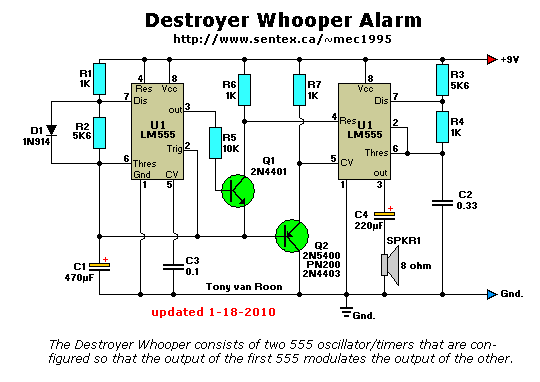
ERRORS FIXED: Emitter of Q1 goes to base of Q2 ONLY (not ground). Value of R1 and R2 were labeled
wrong. R1's value is 1K and is connected between V+ and Pin 7 of IC1. R2's value is 5K6. Value of C4 is lowered to 220uF.
Parts List:
R1,R4,R6,R7 = 1K C1 = 470uF/16V electrolytic
R2 = 5K6 C2 = 0.33uF, ceramic
R3 = 5K6 C3 = 0.1uF (10nF), ceramic
R5 = 10K C4 = 220uF/16V, electrolytic
Q1 = 2N4401 U1,U2 = 555 Timer/Oscillator
Q2 = 2N5400,PN200 D1 = 1N914
2N4403 etc. SPKR1 = Loudspeaker, 8 ohm
A KIT (NO PCB!) is available. [Click Here]
Destroyer Whooper:
If you've ever watched any TV at all and seen those old WWII navy movies, you've heard that distinctive "whoop-whoop-whoop"
as a destroyer sliced through the waves, guns blazing, and everybody yelling "battle stations!" Here is a mp3 sample of
what it sounds like, sound file courtesy of ungaas. [Whooper Destroyer]
Well, I don't have a destroyer. What I've got is an old row boat with an outboard "put-putter" on the stern. But
when I'm put-putting through the harbor on my way to my favorite fishing spot, I sure attract a lot of attention.
This "whooper" makes heads turn. If you really want to attract attention, feed the output to an amplifier first, but
with the correct loudspeaker the output is pretty loud alread. Your choice.
Integrated circuit U1 is connected as a low-frequency asymmetrical oscillator. Its output is inverted by Q1 and fed
to the reset terminal of U2 at pin 4. Integrated circuit U2 is configured as an audio oscillator and is enabled when
the output of U1 is low. With the voltage at pin 5 of U2 constant, the circuit would just "bleep".
The voltage across capacitor C1 is fed to the base of Q2, turning it on and grounding pin 5 of U2. When the frequency
of the reset signal on pin 4 falls, the output frequency of U2 rises. The output then becomes a whoop, starting low
in frequency and ending high.
Resistor R1 sets the repetition rate and R2 determines the time duration of the whoop. Resistors R3 and R4 set the
center-operated frequency.
The values for Q1 and Q2 are not critical. Almost anything will work.
Depending on what loudspeaker type and ohms value you're using, you may have to play with the value of C1, center
frequency resistors R3/R4, and R1 and R2 to adjust the sound and delay to your personal liking. I used an 8 ohm,
2W loudspeaker and the sound is really *very* loud!
Copyright:
This article is © and diagram was submitted by Murray Stein, Miami Florida,
to Byron G. Wels' 'Think Tank' section in Popular Electronics Magazine, July 1989 and published by Gernsback Publishing
(no longer in business). The MP3 sound clip is provided by ungaas. Thanks!
Destroyer Whooper
Back to Circuits Page
Copyright © Tony van Roon
Updated: January 27, 2010

